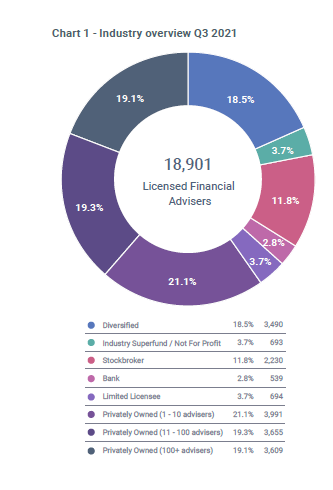It’s often the bad news that can rate the best, which is the case for our Story of the Week, as we reported the further projected decline in adviser numbers by the end of 2021…
Adviser Ratings is forecasting there will be 16,500 advisers for the start of 2022 after FASEA’s exam regulation comes into play, a drop of 20 percent year on year.
The company’s latest Adviser Musical Chairs Report, highlighting financial adviser and licensee movement for the third quarter of 2021, predicts that with the education standards deadline still on the horizon, several thousand advisers will depart the industry in the next few years:
“In fact, we forecast there are still close to 5,000 advisers who will depart before numbers stabilise.”
The firm told Riskinfo the drop to 16,500 advisers forecast by the end of this year takes into account:
- Existing advisers yet to pass the FASEA exam by 31 December, offset by the extension to 30 September 2022 for those advisers who have failed twice before the end of 2021. With only the November round of exams remaining before the end of this year, Adviser Ratings expects approximately 2,000 advisers will no longer be allowed to practice from 1 January 2022 (this also takes into account current pass rates).
- Organic retirements already coming through, especially those from limited licensees, together with risk advisers, who continue to exit the industry at a rate of 2.5 to 1 greater than the average wealth adviser
The report notes that the adviser workforce has now dropped below the 19,000 mark, which is getting closer to the number of advisers who had sat the FASEA exam by September (19,000) and that around nine in ten, or 16,850, have now passed their exam.
Nevertheless, it says, only 14,630 out of those were recorded as active financial advisers on ASIC’s Financial Adviser Register at that time.

Flight risk analysis
The report includes a special feature which shows that trends are beginning to emerge around the types of advisers who are choosing to depart, along with a ‘flight risk’ analysis.
The report says an adviser’s ‘flight risk’ is their likelihood to depart the industry in the next two years and that it’s an assessment based on a number of factors, including behaviour, qualifications, age and personal intentions.
…if looking at advisers who have already left the industry, more than half had a ‘high’ flight risk score…
Adviser Ratings says if looking at advisers who have already left the industry, more than half had a ‘high’ flight risk score, while a further two-in-five had a ‘moderate’ flight risk rating.
“Collectively, more than 90 percent of those who have left showed some early indications that they were on their way out,” the report states.
“When we turn our attention to current advisers, six percent – or roughly 1,100 advisers – have a ‘high’ flight risk. We are fairly confident these advisers will exit the industry in the next two years.”
Meanwhile, the report says a quarter of the remaining advisers – roughly 4,800 – are at ‘moderate’ risk of departure.
“These advisers have a higher propensity than the average adviser to depart the industry.”
It says that putting it all together, more than 30 percent of the current workforce “…is at least a moderate flight risk. In other words, almost a third of advisers (31.6 percent) are showing signs of potential departure.”
The report says that while Adviser Ratings doesn’t expect flight risk to translate into departure in all cases, “…these early indications should raise the alarm. With an impending mass exodus on the cards in the next two years and just a trickle of new talent, many Australians in need of financial advice will struggle to find it.”







Well I guess the Govt, FSC, AFA, FPA & the banks will have almost achieved their desired outcomes. Destroy an industry with no consumer benefits.
The Government is starting to acknowledge that the current regime is not working as planned and the Billions spent, has had the exact opposite effect of the stated objectives, which was more affordable access to Advice.
If the rate of attrition is 2.5 risk advisers for every 1 Investment Adviser, then at what point will the Government sit up and take notice that the Life Insurance Framework, FASEA, BID and 7 safe Harbour steps are making it hard to stay motivated to build upon an uncertain future.
Comments are closed.